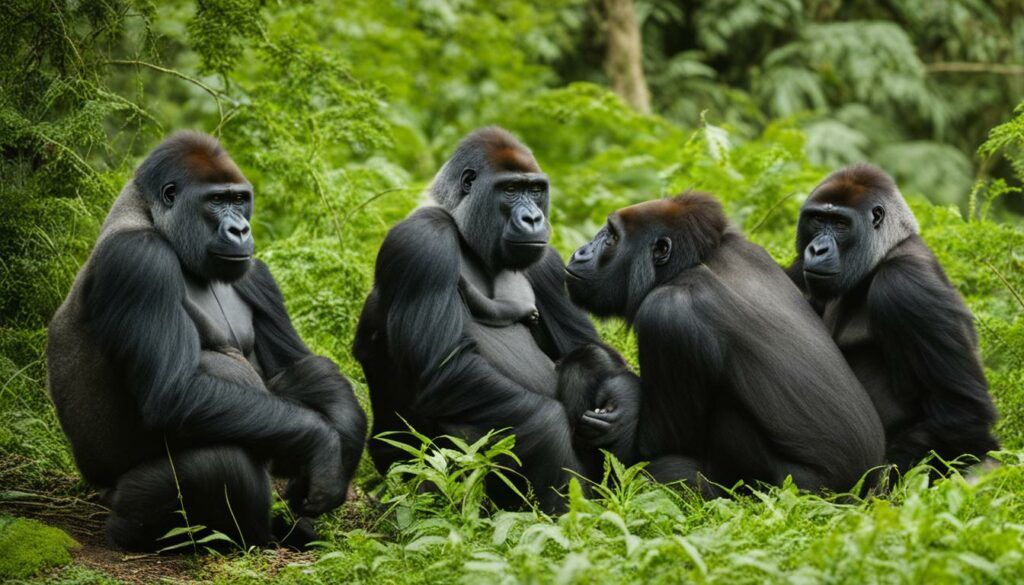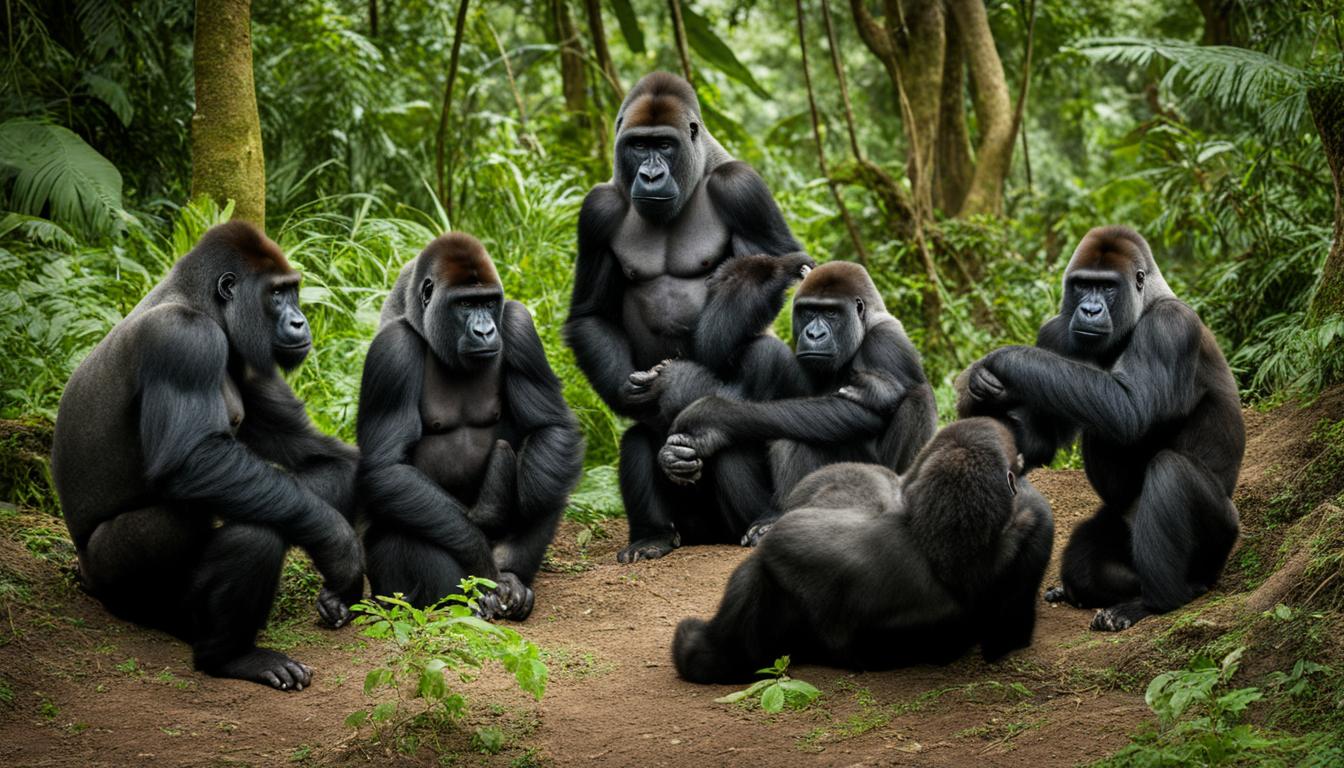Gorillas are fascinating creatures that live in complex social groups. Understanding how social hierarchies are established within gorilla groups provides insights into their behavior, dominance, and group dynamics. Let’s explore the intricate social structure of gorillas and how it influences their interactions.
Gorilla social structure revolves around the dominant male, known as the silverback. The silverback leads and protects the group, ensuring its survival. The success of a silverback’s leadership determines the stability of the group and whether females stay or switch to another silverback.
Factors such as strength, intelligence, and social skills determine the dominance hierarchy among male gorillas. The dominant silverback has the authority to make decisions regarding food, sleeping locations, and group movements. Other silverbacks may assist in maintaining group cohesion and resolving conflicts.
Female gorillas also have their own hierarchy within the group. The dominant female is typically the one with the youngest offspring, as they require the most protection. Age, length of time in the group, and the interest of the dominant male influence the hierarchy among females.
Gorilla groups can vary in size and composition. While the average group size is around 10-12 individuals, it can range from as few as two to as many as 65. The composition consists of one dominant male, multiple adult females, and their offspring. However, there are instances where multiple silverbacks coexist within a group.
In captive settings, efforts are made to maintain species-typical social groupings among gorillas. This includes the formation of bachelor groups to mimic their natural behavior. Juvenile male gorillas learn important skills and behaviors in these bachelor groups before establishing their own family groups.
Understanding how social hierarchies are established and maintained in gorilla groups provides valuable insights into their complex social behavior. It sheds light on the dynamics of these fascinating creatures and the essential role social structures play in their lives.
Dominance hierarchy in male gorillas
Male gorillas establish a dominance hierarchy within the group, with one silverback typically taking on the role of the alpha male. This dominant male is responsible for making decisions about food, sleeping locations, and group movements. Other silverbacks in the group may assist in protecting the group and resolving conflicts. The position of the dominant male is determined by factors such as strength, intelligence, and social skills. Gorilla groups with a clear dominance hierarchy are better able to maintain group cohesion and ensure the survival of the group.
Male gorillas have various strategies for establishing dominance. Some males may leave their natal group and form bachelor groups, where they can learn the necessary skills to become successful leaders. These bachelor groups provide an opportunity for young males, known as blackbacks, to gain experience and eventually establish their own family groups. By observing and learning from older males, blackbacks develop the social and behavioral skills needed to navigate the complex dynamics of gorilla society.
“The establishment of dominance among male gorillas is crucial for maintaining group stability and ensuring the survival of the group as a whole.”
The dominance hierarchy among male gorillas is a fascinating aspect of ape communities. It highlights the importance of strength, intelligence, and social skills in determining leadership roles within the group. Understanding the establishment and maintenance of dominance in male gorillas sheds light on the complex social behavior and dynamics of these remarkable creatures.
Female Hierarchy in Gorilla Groups
In gorilla groups, females also establish their own social hierarchy. The dominant female is usually the one with the youngest offspring, as they require the most protection from the silverback. This dominant position allows her to have priority access to resources and play a crucial role in the survival of the group.
The hierarchy among females is influenced by various factors such as age, length of time in the group, and the level of interest shown by the dominant male. Younger females may have lower ranks initially but can rise in rank as they age and give birth to their own offspring. However, it is important to note that female gorillas generally compete for the attention of the silverback rather than engage in intense competition with each other.
While female-female relationships are not as strong as those among males, limited friendly interactions can occur within the group. These interactions often revolve around grooming and maintaining social bonds. Although females may transfer between groups multiple times throughout their lives in search of better opportunities, they tend to have stable relationships with their offspring, providing them with the necessary care and protection.
The Social Dynamics of Female Gorillas
The social dynamics among female gorillas are characterized by a delicate balance of cooperation and competition. While competition for the silverback’s attention exists, females also rely on cooperation to ensure the survival of the group. The dominance hierarchy among females plays an essential role in maintaining group cohesion and facilitating successful reproduction.
| Hierarchy Rank | Characteristics |
|---|---|
| Dominant Female | Has the youngest offspring and gains priority access to resources. |
| Subordinate Females | Follow the lead of the dominant female and assist in raising offspring. |
| Lower-ranked Females | Have limited access to resources and may be less involved in group dynamics. |
The social hierarchy among female gorillas serves as a mechanism to organize group interactions and allocate resources efficiently. By understanding how female gorillas establish and maintain their hierarchy, researchers gain valuable insights into the intricate social lives of these remarkable animals.

Gorilla Group Size and Composition
Gorilla groups exhibit significant variation in terms of their size and composition. While the average group size ranges from around 10 to 12 individuals, there can be considerable extremes, from as few as two individuals to larger groups of up to 65 members. The size of a group is influenced by various factors, including the availability of resources and the social dynamics within the community. Smaller groups can consist of a single breeding pair or two silverbacks, while larger groups tend to have a more complex social structure.
In most gorilla groups, the composition primarily includes one dominant male, known as the silverback, multiple adult females, and their offspring. This structure is commonly observed in harem-style groups, where the silverback leads and protects the group. However, there are exceptions to this pattern, such as with mountain gorillas, where multiple silverbacks coexist within a group. These coexisting silverbacks often have familial relationships, being closely related to each other. This unique composition adds complexity and diversity to the social dynamics of the group.
To provide a visual representation of the variation in group size and composition among different gorilla species, the following table illustrates the characteristics of several representative species:
| Gorilla Species | Average Group Size | Composition |
|---|---|---|
| Western Gorilla | Around 10 individuals | 1 dominant male, multiple adult females, and offspring |
| Eastern Gorilla | 12-15 individuals | Multiple silverbacks, adult females, and offspring |
| Mountain Gorilla | 10-30 individuals | Multimale, multifemale, multi-offspring groups |
As demonstrated in the table, different gorilla species exhibit varying group sizes and compositions, reflecting the unique social structures and dynamics that have evolved within each species. Understanding these variations contributes to our knowledge of primate behavior and the intricacies of social hierarchies in gorilla communities.
Gorilla Social Structure in Captivity
When it comes to gorilla social structure in captivity, efforts are made to replicate the species-typical groupings observed in the wild. One key aspect of this is the formation of bachelor groups. In these groups, only male gorillas reside together, simulating the behavior seen in their natural habitats. Blackbacks, the juvenile male gorillas who are too old to be considered juveniles but not yet silverbacks, play a crucial role in these bachelor groups.
In the wild, blackbacks would leave their natal group and potentially form bachelor groups, where they can learn valuable skills and behaviors necessary for successful leadership. In captivity, keepers closely monitor the behavior of blackbacks to determine the right time to separate them from their natal group and introduce them to or form a bachelor group. This ensures that young males have the opportunity to learn and develop the necessary social and leadership skills before establishing their own family groups in the future.
By providing bachelor groups in captivity, institutions aim to create an environment that closely mirrors natural social dynamics, allowing gorillas to engage in natural behaviors and learn from one another. This setup is not only enriching for the gorillas but also contributes to their overall well-being and the understanding of their species in a captive setting.
| Advantages of Bachelor Groups in Captivity |
|---|
| Gorillas can learn important social and leadership skills in a safe and controlled environment. |
| Bachelor groups allow gorillas to engage in natural behaviors and social interactions. |
| By replicating wild social structures, bachelor groups contribute to the overall well-being of captive gorillas. |
Bachelor Groups: A Learning Experience
Creating bachelor groups for male gorillas in captivity provides them with a unique learning experience that prepares them for future roles as leaders. These groups allow them to observe and interact with other males, learn social cues and behavior, and develop the necessary skills needed to successfully lead and protect their own family groups in the future. By closely mimicking the wild social hierarchy, captivity environments contribute to the overall conservation efforts and understanding of gorilla social dynamics.
Conclusion
Social hierarchies are a fundamental aspect of gorilla groups, both in their natural habitats and in captivity. The dominant male, known as the silverback, takes on the crucial role of leadership and protection for the group. Females also establish their own hierarchy, with the dominant female typically being the one with the youngest offspring.
Gorilla groups display a range of sizes and compositions, with larger groups typically offering more protection and reproductive opportunities. In some gorilla species, multiple silverbacks coexist within a group, adding complexity to the social structure. The establishment and maintenance of social hierarchies are vital for maintaining group cohesion and ensuring the survival of the gorilla population.
Understanding the dynamics of gorilla groups provides valuable insights into the complex social behavior of these remarkable creatures. From dominance to hierarchy, the intricate relationships within gorilla groups showcase the fascinating nature of primate social structures. These insights contribute to our knowledge of gorilla behavior and aid in conservation efforts to protect these majestic animals and their natural habitats.
Are the ways social hierarchies are established in gorilla groups similar to those in chimpanzee groups?
In gorilla groups, social hierarchies are established through dominant individuals asserting their power over others. Similarly, social hierarchies in chimpanzees are also based on dominance and aggression, with alpha males and females holding the highest status and influencing group dynamics.
FAQ
How are social hierarchies established in gorilla groups?
Social hierarchies in gorilla groups are typically established through dominance interactions. The dominant male, or silverback, assumes the role of leader and protector of the group. Other males may also have a hierarchical structure within the group. Females also have their own hierarchy based on factors such as age, length of time in the group, and their relationship with the dominant male.
What is the dominance hierarchy like among male gorillas?
In gorilla groups, one silverback usually assumes the dominant position. This dominant male makes decisions regarding food, sleeping locations, and group movements. Other silverbacks may assist in protecting the group and resolving conflicts. The dominance of a male gorilla is determined by factors such as strength, intelligence, and social skills. Some male gorillas may leave their natal group and form bachelor groups to learn the necessary skills to become successful leaders.
How does the hierarchy work among female gorillas?
Female gorillas also have a hierarchy of their own within the group. The dominant female is typically the one with the youngest offspring, as they require the most protection from the silverback. Factors such as age, length of time in the group, and the interest of the dominant male influence the hierarchy among females. While female gorillas generally compete for the attention of the silverback, they have limited friendly relationships with other non-related females in the group.
What is the size and composition of gorilla groups?
Gorilla groups can vary significantly in size and composition. The average group size is around 10-12 individuals, but it can range from as few as two individuals to as many as 65. Most gorilla groups consist of one dominant male, multiple adult females, and their offspring. However, in some instances, such as with mountain gorillas, multiple silverbacks coexist within a group. The size and composition of a group can impact its protection and overall dynamics.
How does gorilla social structure differ in captivity?
In captive settings, efforts are made to maintain species-typical social groupings among gorillas. This includes the formation of bachelor groups, consisting of only male gorillas. Juvenile male gorillas, known as blackbacks, are carefully monitored to determine when they should be separated and join or form a bachelor group. These bachelor groups provide valuable learning experiences for young males before they establish their own family groups.
What role do social hierarchies play in gorilla groups?
Social hierarchies play a crucial role in gorilla groups, both in the wild and in captivity. Dominant males, or silverbacks, lead and protect the group, while females have their own hierarchies based on factors such as age and their relationship with the dominant male. Understanding the establishment and maintenance of social hierarchies in gorilla groups sheds light on the complex social behavior and dynamics of these awe-inspiring creatures.











